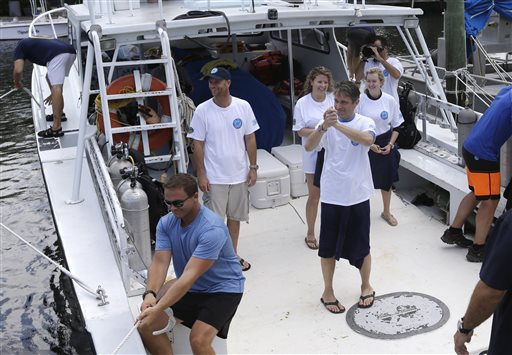ISLAMORADA, Fla. - Fabien Cousteau says his 31-day underwater living experiment in the Florida Keys was a monumental success that used tools of which his famous ocean explorer grandfather could only dream.
Cousteau and a team of filmmakers and scientists dove June 1 to Aquarius Reef Base to study what effects climate change and pollution are having on a coral reef.
The crew started decompression Tuesday inside the pressurized lab, 63 feet below the ocean's surface off Key Largo. They resurfaced Wednesday and returned to the Aquarius command center in Islamorada.
The entire expedition was broadcast in real time online, and Cousteau held video chats with classrooms worldwide.
Cousteau says he was struck by the sunlight and fresh air when he emerged Wednesday morning, but he already missed his underwater home.
5 things to know about Cousteau's undersea mission
ISLAMORADA, Fla. - Fabien Cousteau comes from a famous family of filmmakers, advocates and ocean explorers, and now he's added to their legacy of sea stories a 31-day expedition at an underwater laboratory in the Florida Keys. Here are five things to know about Cousteau's "Mission 31," which ended Wednesday.
THE AQUANAUTS
Cousteau and two technicians spent 31 days living and working underwater at Aquarius Reef Base. Filmmakers and researchers from Florida International University, Northeastern University and MIT also joined him for two-week-long stretches during the expedition.
AQUARIUS REEF BASE
The 460-square-foot pressurized lab sits 63 feet below the ocean's surface in the Florida Keys National Marine Sanctuary with bunks for six. It's owned by the federal government and operated by Florida International. It allows its inhabitants to scuba dive for up to nine hours without needing to resurface or undergo decompression.
SCIENTIFIC PURPOSE
The crew dove June 1 to study the effects of climate change and pollution on a nearby coral reef. Researchers said they were able to gather up to two years' worth of data in just a few weeks because they were living underwater. Among other projects, they studied pollution on the reef, overfishing of predators and the effect on their prey. They also set up long-term monitoring equipment to study ocean acidification and coral probes that are the size of a human hair. In addition, they tested a camera that captures animal behavior in slow motion and a sonar device that collects data over a wide range of frequencies, thus increasing the amount of information it collects.
FAMILY LEGACY
Cousteau is the grandson of ocean exploration pioneer Jacques Cousteau, who helped develop the advanced diving techniques used at Aquarius. "Mission 31" was conceived as a nod to Conshelf II, a 30-day underwater living experiment in the Red Sea that the elder Cousteau filmed for his Oscar-winning documentary "World Without Sun." The crew watched the documentary while undergoing decompression for roughly 16 hours before resurfacing.
MARINE LIFE
Cousteau said a multitude of marine life appeared around the lab: starfish, plankton, a hammerhead shark and other reef sharks, a Goliath grouper that attacked a barracuda, pork fish, tarpon, spotted eagle rays, snook, manta shrimp, eels, octopus and sponges.

